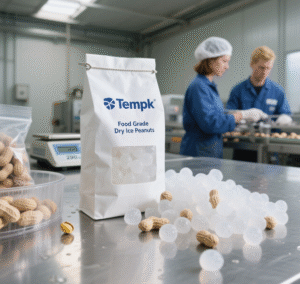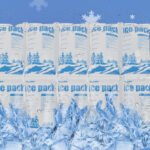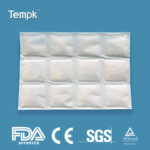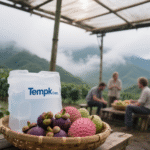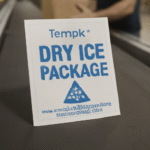-
What “dry ice packing peanuts” really means
-
Der 2025 Regeln, die Sie erfüllen müssen (Iata, PUNKT, USPS)
-
Schritt -für -Step -Packout (Prüfungsrede)
-
Wie viel Trockeneis? Schneller Schätzer
-
Which peanuts: EPS vs. biodegradable vs. paper
-
CO₂ safety: Belüftung, exposure limits, Beschilderung
-
QA: Etiketten, documents, acceptance checks
-
FAQs
1) Was "dry ice packing peanuts”Bedeutet wirklich
Direkte Antwort: It’s the combination aus Trockeneis (to hold temperature) and packing peanuts (to remove dead air and prevent product movement) inside an isoliert, entlüftet Absender. Regulations require CO₂ to vent; packages must be marked Und 1845 und zeigen die net mass of dry ice (kg).
Air waybill text: Many university and carrier job‑aids require wording similar to: „Trockeneis, 9, UN1845, number of packages X, net weight in kilograms.” Check your operator’s variation.
2) Der 2025 Regeln, die Sie erfüllen müssen (Iata, PUNKT, USPS)
-
IATA DGR 66th ed. (2025) + Addendum 1 (Apr 30, 2025): Dry ice shipped without other DG uses the Acceptance Checklist for Dry Ice (Wenn die Erklärung eines Versenders nicht erforderlich ist). Keep state/operator variations in mind.
-
PUNKT (UNS) 49 CFR §173.217: Packaging must CO₂ -Freisetzung erlauben; markieren Und 1845 und die Netzmasse of dry ice on the package.
-
USPS Publication 52, Instr. 9A (domestic mail): Specific limits/packaging for dry ice; follow §349 plus 9A details for air pieces. International mail with dry ice is prohibited.
Notiz: Some acceptance job‑aids and EHS guides cite 200 kg max net dry ice per package under PI 954; operators may set stricter limits—always check carrier variations.
3) Schritt -für -Step -Packout (Prüfungsrede)
-
Pick the shipper: EPS/EPP cooler (VIP for long lanes) nested in a corrugated outer.
-
Prep the payload: Bag/seal anything that may leak or thaw.
-
Load dry ice: Ort around and above the product (Tun nicht wrap or seal dry ice); the package must Entlüftung.
-
Hohlräume füllen: After loading dry ice, eliminate remaining air space with packing peanuts or crumpled paper to immobilize contents and slow sublimation.
-
Schließen & markieren: Anwenden Klasse 9 Etikett, Und 1845, NET Dry -Ice Kg, and shipper/consignee addresses to a vertikale Seite panel; complete air waybill text.
Für die Spitze (acceptance speed): FedEx job‑aids highlight UN‑number mark size guidance (≥ 12 mm bei der Packungskapazität >30 kg). Check the current job‑aid for your region.
4) Wie viel Trockeneis? Schneller Schätzer
Planning rule of thumb: 5–10 lb (2.3–4,5 kg) pro 24 H for small insulated shippers (validate on your lane; add a delay buffer).
Schätzer (include a buffer):
-
Wählen days = ceil(hours/24)
-
Fangen Sie an 3.6 kg/day (midpoint) × cooler factor (0.6 good / 1.0 Durchschnitt / 1.4 poor)
-
Hinzufügen 20% Verzögerungspuffer.
Beispiel: 48 H, average cooler → 3.6×2×1.0 = 7.2 kg → +20% ≈ 8.6 kg Trockeneis.
5) Which peanuts: EPS vs. biodegradable vs. paper
| Material | Best use with dry ice | Moisture behavior | Weight impact | Notizen |
|---|---|---|---|---|
| EPS (Polystyrol) Erdnüsse | Robust lanes; humid routes | Low moisture sensitivity | Lightest | Check local bans on EPS loose‑fill (Z.B., NY statewide since 2022; WA since 2023; OR law effective 2025 prohibits sale of foam peanuts). |
| Biodegradable starch peanuts | Eco‑messaging; dry lanes | Water‑soluble; can slump with condensation | Heavier per volume (typ. 0.4–0.8 lb/ft³) | Starch films/coatings are hydrophilic; moisture resistance is weaker unless modified. |
| Paper/honeycomb | Bracing corners; humid routes | Low moisture risk | Mäßig | Recycelbar; good mixed with EPS or starch depending on route. |
Why fill voids at all? Dead‑air space speeds sublimation; removing it helps retain refrigerant and stabilizes temperature.
6) CO₂ safety: Belüftung, exposure limits, Beschilderung
-
Gasvolumen: 1 lb dry ice → ~8.3–8.7 ft³ CO₂ at ambient conditions—plan room ventilation and vehicle airflow accordingly.
-
Expositionsgrenzen: OSHA PEL 5,000 ppm (8-H zwei); Niosh Stel 30.000 ppm, Idlh 40.000 ppm. Use monitors in small staging rooms.
-
Do not airtight‑seal inner liners or coolers; Verpackung muss allow CO₂ to vent.
7) QA: Etiketten, documents, acceptance checks
-
Air waybill (when no DG declaration): Include “Dry ice, 9, UN1845, number of packages X, net weight in kilograms.”
-
Acceptance checklist: Use IATA’s Checkliste zur Akzeptanz von Trockeneisakzeptanz and your carrier’s job‑aid at tender.
-
Common errors: Missing net kg, labels on top/bottom panels, or covering marks with tape. Follow carrier job‑aids for placement/size.
8) FAQs
Q1. Is there really a product called “dry ice packing peanuts”?
NEIN. It’s a packout method: dry ice for cooling + peanuts for Hohlraumfüllung inside a entlüftet insulated shipper marked Und 1845 with net kg.
Q2. Wie viel Trockeneis für 48 Std.?
Most small/medium insulated parcels plan ~5–10 lb per day; for 48 h you’ll typically load 5–9 kg, plus a delay buffer. Validate on your lane.
Q3. Can I use biodegradable peanuts with dry ice?
Yes—just keep them trocken. Starch‑based loose‑fill is water‑soluble and can slump under condensation; choose EPS or paper for humid routes.
Q4. What must be on the box?
Klasse 9 Etikett, Und 1845, Und net dry‑ice weight (kg), plus shipper/consignee addresses; follow IATA/49 CFR and carrier job‑aids.
Q5. Are there state bans impacting EPS peanuts procurement?
Ja. Beispiele: NY (2022), WA (2023), OR (2025) restrict sale/distribution of EPS loose‑fill. Source EPS alternatives when shipping into those markets.






